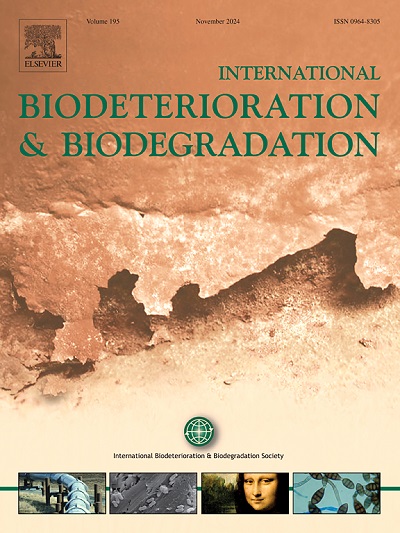副fortutuum分枝杆菌J101降解邻苯二甲酸酯的途径及其增强生物修复的能力
IF 4.1
2区 环境科学与生态学
Q2 BIOTECHNOLOGY & APPLIED MICROBIOLOGY
International Biodeterioration & Biodegradation
Pub Date : 2025-04-18
DOI:10.1016/j.ibiod.2025.106085
引用次数: 0
摘要
邻苯二甲酸酯(PAEs)是一种顽固性污染物,通常用作增塑剂,其降解最有效的是微生物。然而,降解机制的具体方面,特别是上部降解途径中的酶特异性和催化过程仍不清楚。此外,在许多细菌属中,编码负责初始PAE水解的酯酶的基因尚未得到最终鉴定。本研究发现,在初始浓度为100 mg/L的条件下,菌株J101能够在7天内高效降解和矿化3种PAEs:短链邻苯二甲酸二甲酯(88.57%)、邻苯二甲酸二乙酯(96.83%)和邻苯二甲酸二丁酯(99.37%)。pH小于6、盐度大于5%等环境条件会影响菌株J101对PAE的降解效率。基因组挖掘揭示了可能参与J101完全降解PAEs的基因,这与J101观察到的代谢活性和基因表达相对应。cu0019基因编码一种角质酶,该酶能够在上部途径中水解PAEs进行初始降解。PAEs转化为邻苯二甲酸,随后转化为原儿茶酸,最终转化为CO2和H2O。微观研究表明,菌株J101的引入显著提高了混合PAEs的降解效率,并与本地微生物协同作用。此外,菌株J101的加入增加了垃圾土壤细菌群落内部相互作用的多样性和复杂性。因此,菌株J101在pae污染环境的生物修复中具有重要的应用潜力。本文章由计算机程序翻译,如有差异,请以英文原文为准。

Biodegradation pathways of phthalate esters by Mycolicibacterium parafortuitum J101 and its ability to enhance bioremediation
Phthalate esters (PAEs) are recalcitrant pollutants commonly used as plasticizers, and their degradation most effectively occurs by microorganisms. However, specific aspects of the degradation mechanism, particularly enzyme specificity and catalytic processes in the upper degradation pathway, remain unclear. Additionally, genes encoding esterases responsible for initial PAE hydrolysis have not been conclusively identified in many bacterial genera. In this study, Mycolicibacterium parafortuitum strain J101 was found to be capable of efficiently degrading and mineralizing three PAEs at an initial concentration of 100 mg/L in 7 days: short-chain dimethyl phthalate (88.57 %), diethyl phthalate (96.83 %), and dibutyl phthalate (99.37 %). Environmental conditions such as a pH less than 6 and greater than 5 % salinity affect the PAE degradation efficiency of strain J101. Genome mining revealed genes potentially involved in the complete degradation of PAEs by J101, which corresponds with J101's observed metabolic activity and gene expression. The cut0019 gene encodes a cutinase enzyme that is capable of hydrolyzing PAEs for initial degradation in the upper pathway. PAEs are transformed to phthalic acid, subsequently converted to protocatechuate and ultimately transformed to CO2 and H2O. A microcosm study revealed that the introduction of strain J101 significantly enhanced the efficiency of the degradation of mixed PAEs, and the strain synergized with indigenous microorganisms. Furthermore, the addition of strain J101 in landfill soil increased the diversity and complexity of interactions within the landfill soil bacterial community. Consequently, strain J101 demonstrates significant potential for application in the bioremediation of PAE-polluted environments.
求助全文
通过发布文献求助,成功后即可免费获取论文全文。
去求助
来源期刊
CiteScore
9.60
自引率
10.40%
发文量
107
审稿时长
21 days
期刊介绍:
International Biodeterioration and Biodegradation publishes original research papers and reviews on the biological causes of deterioration or degradation.

 求助内容:
求助内容: 应助结果提醒方式:
应助结果提醒方式:


